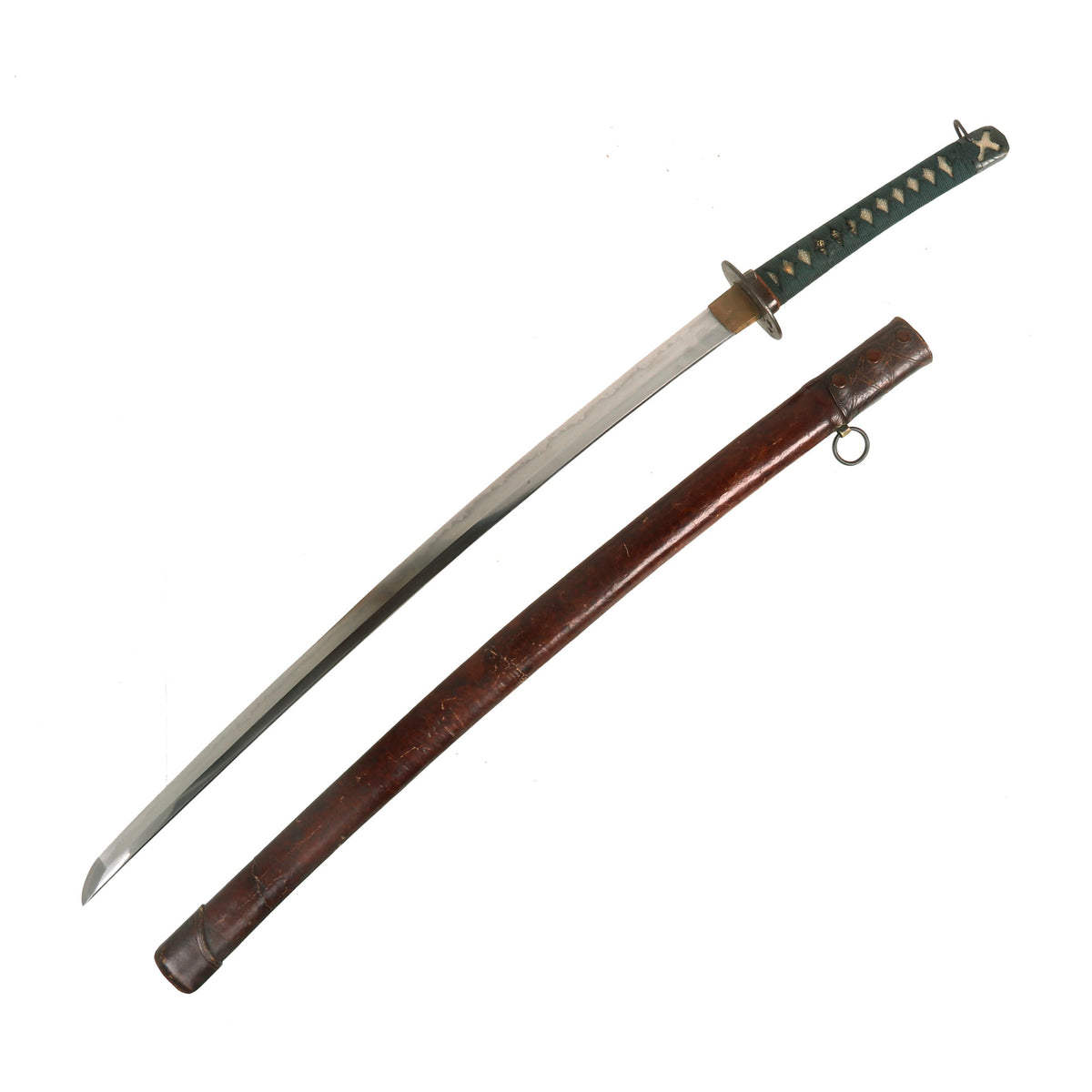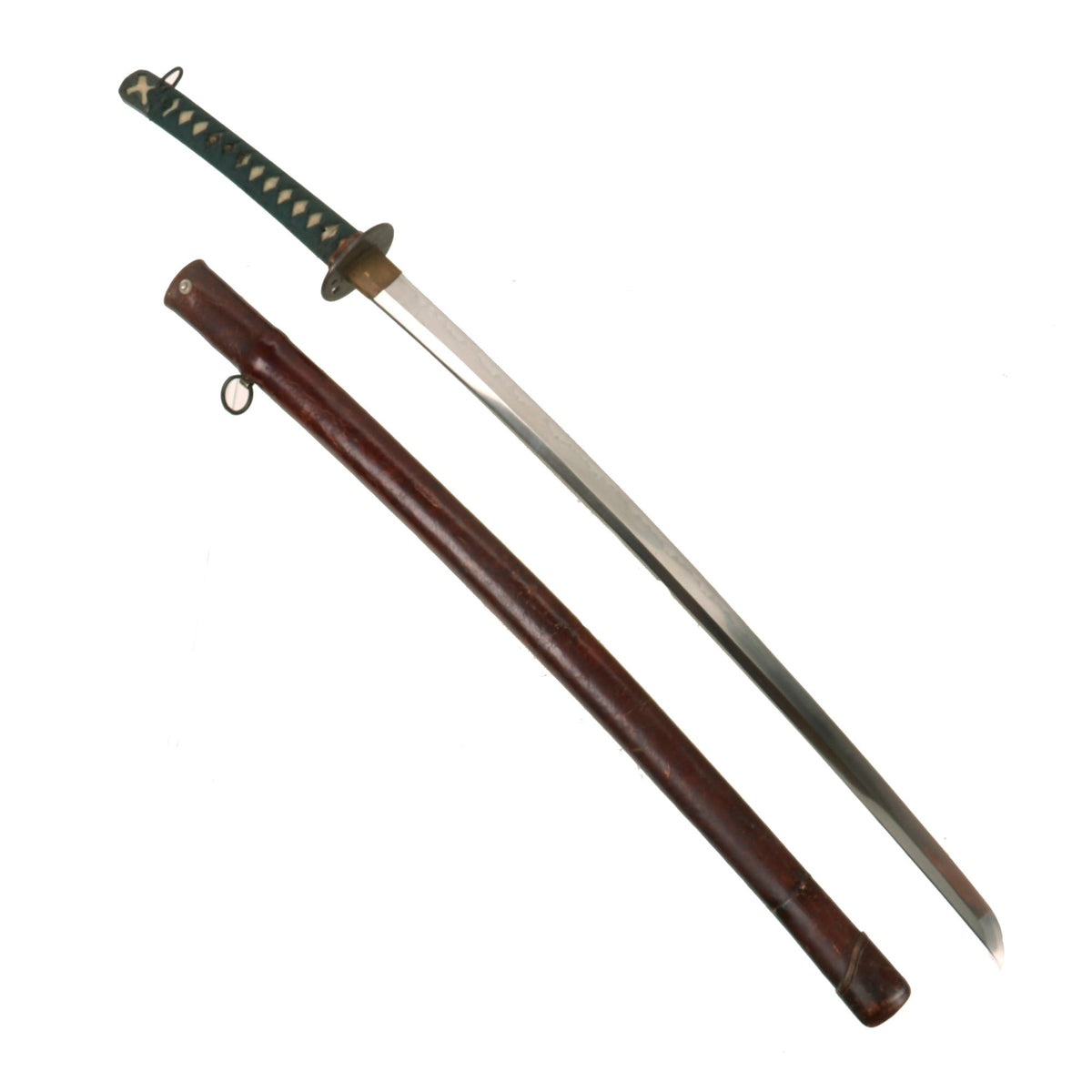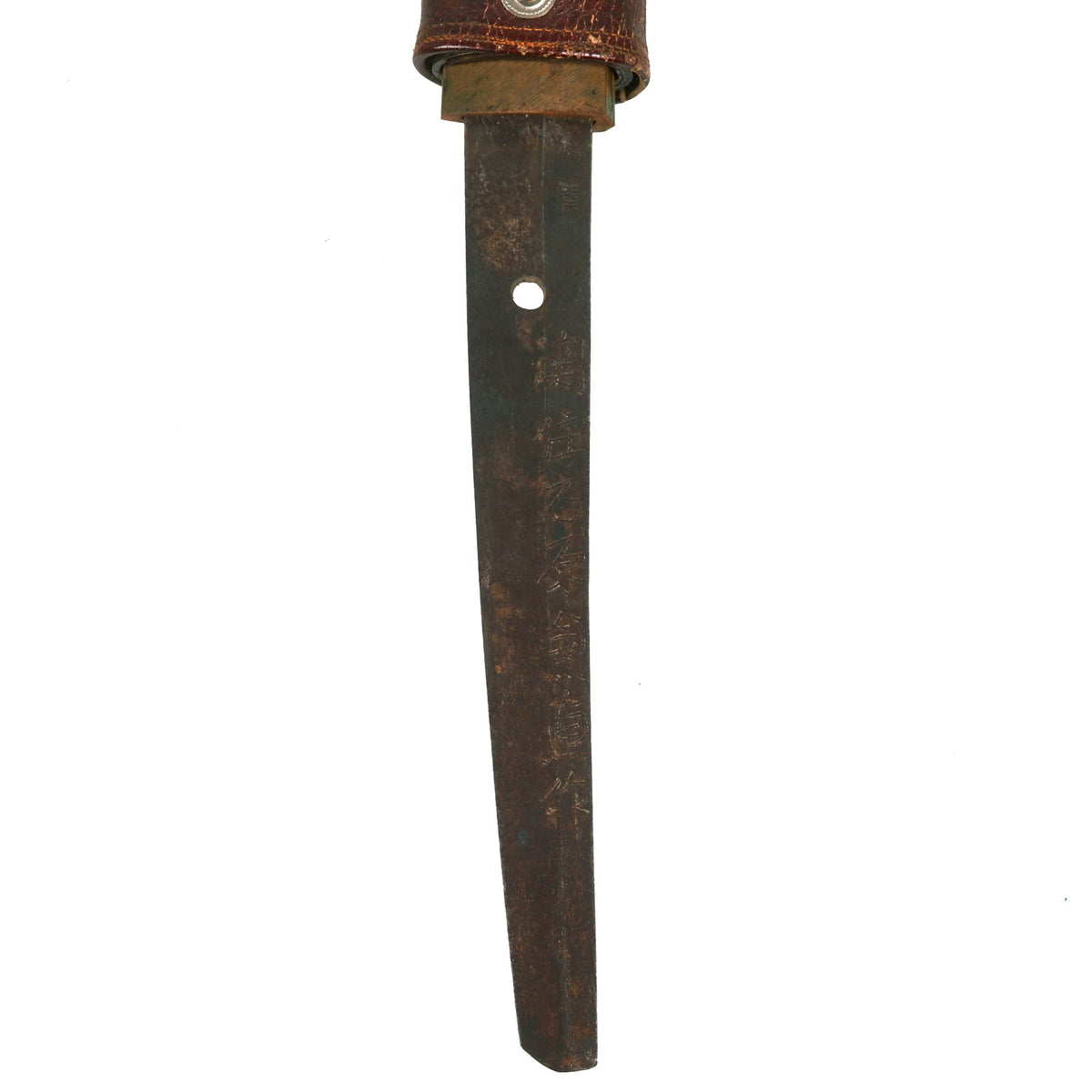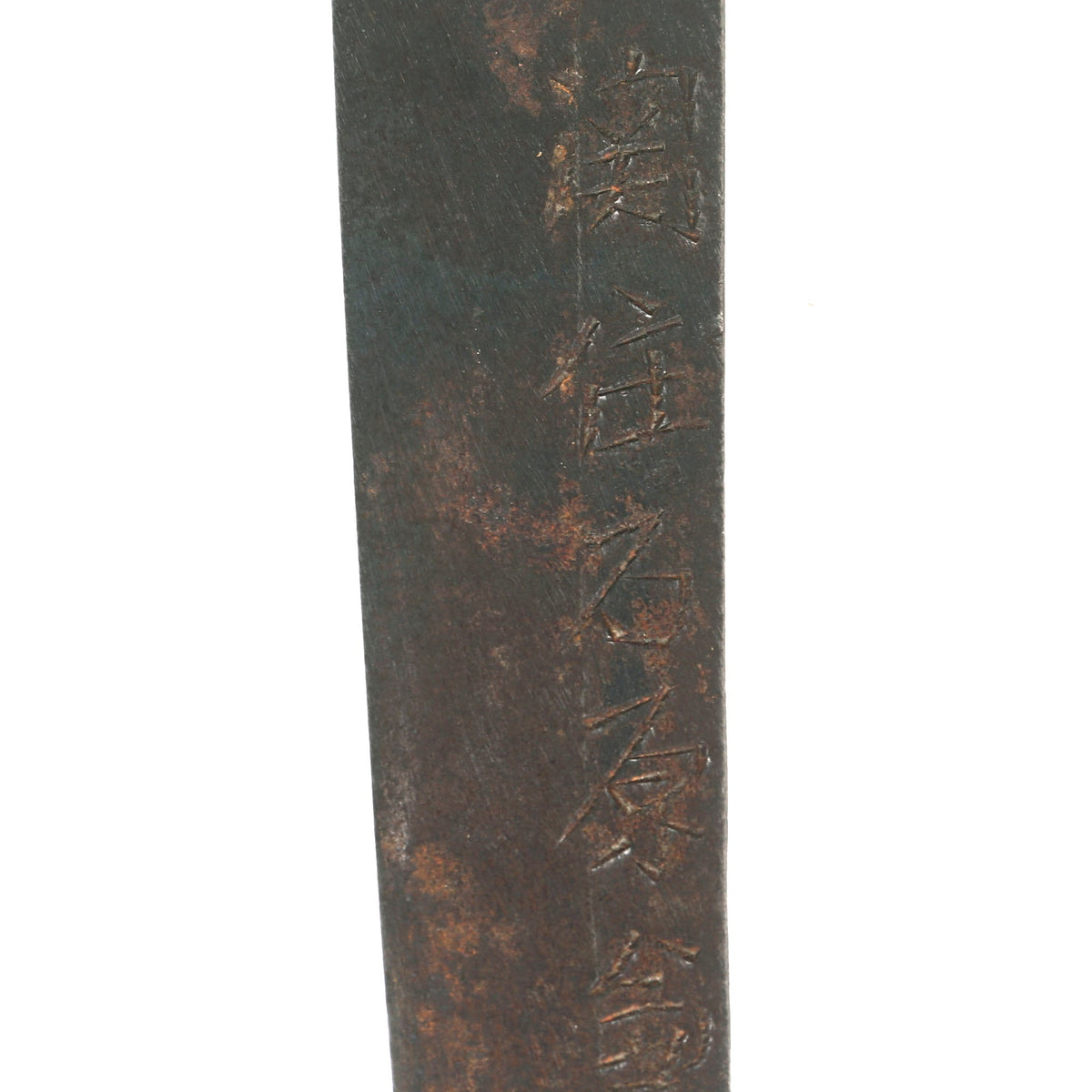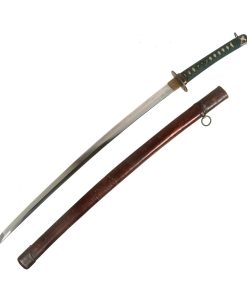Original Excellent WWII Japanese Army Civilian Shin-Gunto Katana by ISHIHARA KANENAO with Leather Covered Wooden Scabbard Original Items
$ 2.495,00 $ 623,75
Original Item: One of a Kind. Recently purchased at an estate sale, this is a fantastic USGI Bring-Back wartime production Japanese Katana in an Army Civilian Shin-Guntō (新軍刀, new military sword) setting. These type of fittings (koshirae) were for Civilian employees of the Imperial Japanese Army, and are a lot more variable than the usual Army Officer Type. They are much closer to traditional fittings, without the cherry blossom motifs seen on Officer swords.
The excellent blade on this example was hand forged, and the tang of the blade is signed (Mei) with the characters 関 住 石 原 兼 直 作, read as SEKI JU ISHIHARA KANENAO SAKU. This translates to Made by Ishihara Kanenao at Seki. Research indicates that this smith’s real name was 石原 金直 (Ishihara Kinnao or Kane Nao), so in this case “Ishihara” was their family name, and “Kanenao” their “swordsmith name.” We have seen many other smiths sign their swords in this fashion, and in this case they just changed one of the kanji in their given name. Their name appears in the Seki Tanrensho Booklet printed in 1939.
Yoshinori was active during the Showa Period and worked at Seki arsenal in Gifu, Mino Province (美濃国), and is stamped 関 (SEKI) on the tang. They look to have made both arsenal forged and traditional blades. We have confirmed the signature (Oshigata) with other examples of his work.
The blade is handmade and was expertly crafted by a sword maker, which is indicated by a few tell-tale characteristics that include:
– Folded steel blade (fold lines are evident on the spine and body of the blade)
– Blade is signed on the tang by the maker (“Mei”)
– Hole in the tang (mekugi-ana) is punched and not drilled
– Visible vibrant temper line (hamon) running full length of blade cutting edge, with crystallization visible (Nie and Nioi)
– Hada or Grain is visible throughout the blade surface.
– Blade has a proper geometric kissaki (tip).
Offered in excellent condition, the polish on the blade of this example is in great shape, showing little to no use since the last time it was polished. The aspects of the blade and temper line are easily seen in any type of light. It is still quite sharp, with no edge issues we can see, just a bit of light scuffing in areas. The blade length is approximately 26 ½” and the overall length is 37 ⅜”. It has a futsu 普通 (regular) Nakago with an Haagari (asymmetrical rounded) nakago-jiri (tang tip). The blade shape is SHINOGI-ZUKURI, which is the “standard” shape for most Katana and longer wakizashi.
The main edge Temper line (hamon) is fully visible, and is a very attractive YAHAZU MIDARE (矢筈乱れ – irregular arrow notch shaped) type. Along the transition there are clear NIE crystals visible, with cloudy areas of NIOI in the body of the hamon, and some nice activity. This includes sanagushi and kinsuji both visible inside and just above the main temper line. There may also be some crescent shaped “uchinoke” aspects as well. The body of the blade (JI) also shows hada (肌 – grain) in the light, which is the ITAME (板目 – wood grain) pattern. The blade has a proper kissaki (tip) with a clear yokote (division between body and tip) and boshi (tip temper line). The latter is still clearly visible visible, and is of the OO-MARU (大丸 – large round boshi turnback) type. With the long delay for traditional togishi polishing, blades like this that are ready to display are definitely in demand.
The fittings are typical of what we see the Army Civilian Employee Shin-Gunto katanas during the WWII period, with a very nice embossed iron MARU GATA round tsuba (cross guard), with two seppa (spacers). It has both Hitsu-ana (accessory holes) for both the Kozuka (kogatana handle) and kogai (hair ornament). The Tsuka (handle) has an excellent stingray (Sa-Me) grip panels, covered with complete green Ito (cloth binding), which is in very good condition, but does show some staining and wear from use. This holds two menuki in place, which look to be brass dogs with nice antiquing. The fuchi (grip collar) and kashira (end cap) are both brass, with some nice designs, though the fuchi is covered with a piece of leather, which used to have a strap connected to it that snapped onto the scabbard field cover. The habaki (blade collar) is copper, seen commonly on Showa era private purchase blades.
The scabbard is brass fitted wood, and is covered with a lovely matured brown leather field cover. It has had a brass hanger ring fitting with a steel ring installed, which is the common way to adapt “civilian” style mounts to military use. The snaps still open, and by opening the top just a bit we can see that the wooden scabbard originally had a gold flake lacquer finish, which must have been lovely in its prime. Due to having shrunk, the leather cover can no longer be removed from the scabbard. It has a snap on the reverse side that would attach to a strap from the sword, however the strap is missing.
A lovely handmade Japanese Army Civilian Employee type Shin-gunto by a known maker with a fantastic blade! This is a real USGI bring-back from WWII, ready to display and cherish!
Specifications:
Blade Length: 26 ½”
Blade Style: Shinogi-Zukuri
Overall length: 37 ⅜”
Scabbard Length: 30″
It has been over one thousand years ago that the art of making swords appeared in Japan. The swordsmiths of the time may not have known it but they were creating a legendary sword. The Samurai sword has seen combat in many battlefields. From the early days of the Samurai warrior to the fierce battles in the South Pacific during WWII.
Each hand-made Samurai sword is unique because it is forged from folded steel stock. A tremendous amount of work is dedicated to creating these pieces. They were an instrument of war as much as a beautiful artifact to adorn a room.
The Samurai sword has grown to be one of the most highly desired military antiques.
Fast Shipping with Professional Packaging
Thanks to our longstanding association with UPS FedEx DHL, and other major international carriers, we are able to provide a range of shipping options. Our warehouse staff is expertly trained and will wrap your products according to our exact and precise specifications. Prior to shipping, your goods will be thoroughly examined and securely secured. We ship to thousands clients each day across multiple countries. This shows how we're dedicated to be the largest retailer on the internet. Warehouses and distribution centres can be located throughout Europe as well as the USA.
Note: Orders with more than one item will be assigned a processing date depending on the item.
Before shipping before shipping, we'll conduct a thorough inspection of the items you have ordered. Today, the majority of orders will be delivered within 48 hours. The delivery time will be between 3-7 days.
Returns
The stock is dynamic and we cannot completely manage it because multiple stakeholders are involved, including our factory and warehouse. So the actual stock may alter at any time. It's possible that you may not receive your order once the order has been made.
Our policy is valid for a period of 30 days. If you don't receive the product within 30 days, we are not able to issue a refund or an exchange.
You can only return an item if it is unused and in the same state as the day you received it. You must have the item in its original packaging.
Related products
Uncategorized
Uncategorized
Uncategorized
Uncategorized
Band of Brothers ORIGINAL GERMAN WWII Le. F.H. 18 10.5cm ARTILLERY PIECE Original Items
Uncategorized
Uncategorized
Uncategorized
Uncategorized
Uncategorized
Angolan Rebel 1970s era 60mm Inert Display Mortar from Angolan Civil War Original Items
Uncategorized
Uncategorized
Uncategorized
Uncategorized
Australian WWII Owen MK1 Machine Carbine SMG Custom Fabricated Replica with Sling Original Items
Uncategorized
Uncategorized
Uncategorized
